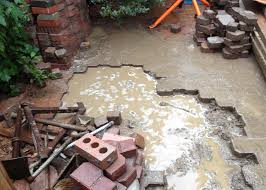Signs Your Property Has Drainage Problems and What to Do

When it comes to homeownership, ensuring that your property is well-maintained is essential for both comfort and investment protection. One crucial aspect of home maintenance that often gets overlooked is proper drainage. Without it, water can wreak havoc on your property, leading to a myriad of costly and disruptive problems.
In this blog post, we will explore the signs that your property has drainage problems and provide actionable solutions to address these issues.
Signs of Drainage Problems
Identifying drainage problems early can save homeowners from extensive damage and expensive repairs. Here are some visible and less obvious signs that your property may be suffering from poor drainage:
Visible Signs
- Pooling Water: One of the most obvious indicators of drainage problems is standing water. If you notice water pooling around your yard, driveway, or near the foundation after rain, it’s a clear sign that your drainage system needs attention.
- Damp Spots: Persistent damp spots or patches of soggy grass can indicate that water is not draining properly. This is especially concerning if these spots are near your home’s foundation.
- Mold Growth: Mold or mildew on walls, particularly in the basement or ground floor, can be a sign of excess moisture due to poor drainage.
Less Obvious Indicators
- Cracks in the Foundation: Water that doesn’t drain away from the foundation can lead to cracks. Over time, these cracks can compromise the structural integrity of your home.
- Uneven Landscape: If parts of your yard are sinking or becoming uneven, this may indicate that water is eroding the soil beneath the surface.
- Water Stains: Water stains on walls, especially in the basement, are a subtle sign that water is seeping into your home.
The Impact of Poor Drainage
Ignoring drainage problems can lead to serious damage to your property, including:
- Foundation Damage: Water that accumulates around the foundation can weaken it, leading to cracks and instability.
- Basement Flooding: Poor drainage can result in water seeping into the basement, causing flooding, mold growth, and damage to stored items.
- Landscape Erosion: Excessive water can erode soil and damage plants, leading to an unsightly and unhealthy yard.
- Structural Issues: Persistent moisture can weaken the structure of your home, leading to costly repairs in the long run.
Solutions for Common Drainage Issues
Addressing drainage problems promptly can help protect your property from significant damage. Here are some strategies to improve drainage around your home:
Improving Yard Drainage
- French Drains: Installing a French drain can help redirect water away from problem areas. This involves digging a trench, placing a perforated pipe, and covering it with gravel.
- Swales: Swales are shallow ditches that help channel water away from your property. They can be landscaped to blend with your yard.
- Dry Wells: Dry wells collect excess water and allow it to slowly percolate into the ground, preventing pooling.
Maintaining Gutters and Downspouts
- Regular Cleaning: Ensure that gutters and downspouts are free of debris to allow water to flow freely.
- Extensions: Extend downspouts away from your home’s foundation to prevent water from accumulating near the base of your house.
- Check for Leaks: Inspect your gutters and downspouts for leaks and repair them promptly.
Selecting and Installing Proper Drainage Systems
- Surface Drains: Install surface drains in areas where water tends to pool. These drains collect and redirect water away from your property.
- Grading: Proper grading ensures that water flows away from your home. If your yard slopes toward your house, regrading may be necessary.
- Sump Pumps: In areas prone to basement flooding, sump pumps can be an effective solution to remove water quickly.
Professional Help
While some drainage issues can be resolved with DIY solutions, others require professional intervention. Here’s when to seek professional help and how to choose the right contractor:
When to Seek Professional Assistance
- Persistent Issues: If you’ve tried DIY solutions but still notice drainage problems, it’s time to call in a professional.
- Foundation Problems: Cracks in the foundation or severe water damage should be assessed by a qualified contractor.
- Large-Scale Projects: Major drainage installations, like regrading or installing extensive drainage systems, are best handled by experts.
How to Choose the Right Contractor
- Experience: Look for contractors with experience in solving drainage issues. Ask for references and check reviews.
- Licensing and Insurance: Ensure the contractor is licensed and insured to protect yourself from liability.
- Detailed Proposals: Request detailed proposals outlining the scope of work, materials, and costs involved.
- Local Knowledge: A local plumber from Murray, Utah, for instance, will have specific knowledge about the area’s drainage challenges and regulations.
Conclusion
Proper drainage is essential for maintaining the structural integrity and beauty of your home. By being vigilant and addressing drainage issues early, homeowners can avoid costly repairs and ensure a safe, dry living environment. Remember, proactive maintenance is key to protecting your property. If you notice any signs of drainage problems, don’t hesitate to take action.
Share your experiences and tips for managing drainage issues in the comments below. Let’s help each other keep our homes safe and dry!



